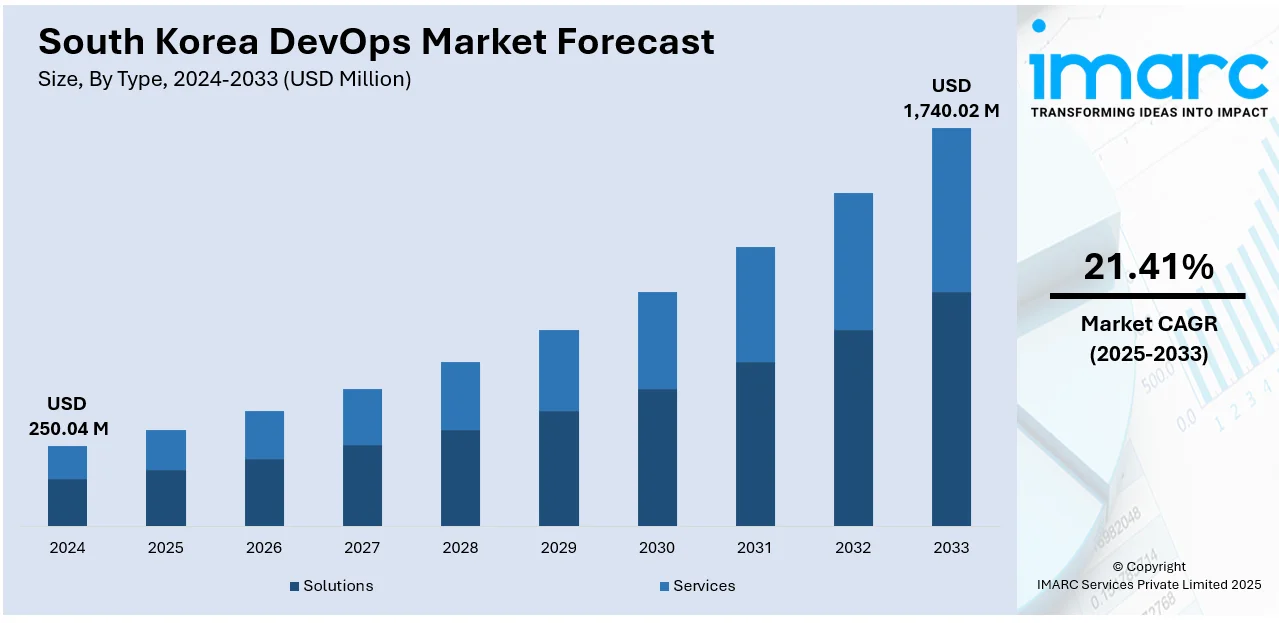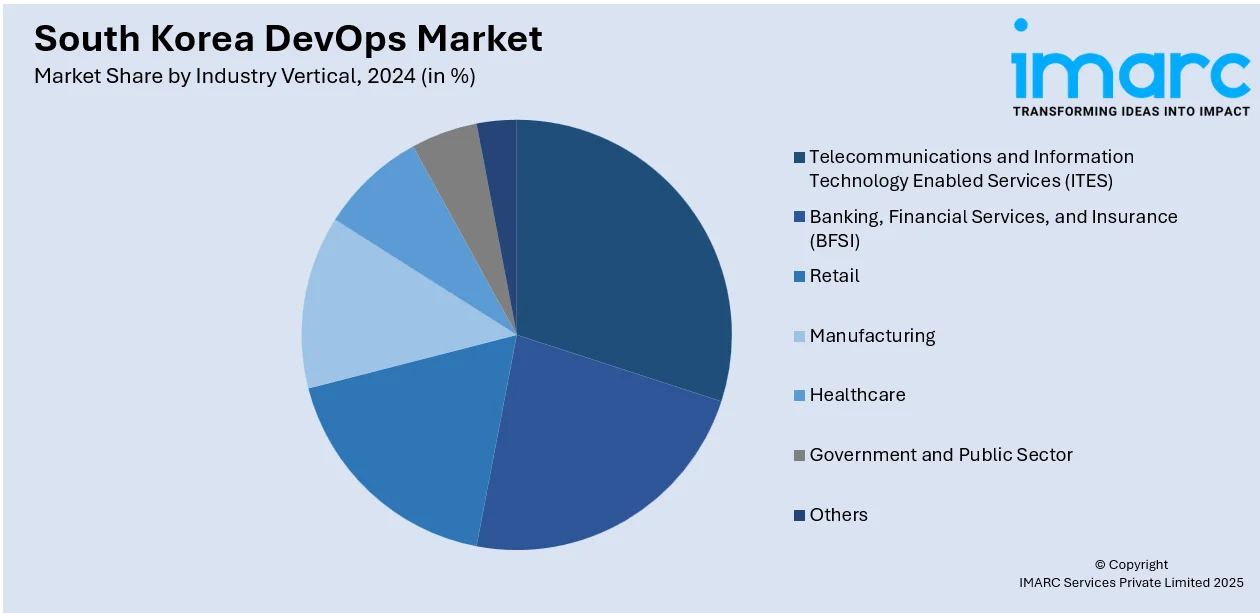
South Korea DevOps Market Size, Share, Trends and Forecast by Type, Deployment Model, Organization Size, Tool, Industry Vertical, and Region, 2025-2033
South Korea DevOps Market Overview:
The South Korea DevOps market size reached USD 250.04 Million in 2024. Looking forward, IMARC Group expects the market to reach USD 1,740.02 Million by 2033, exhibiting a growth rate (CAGR) of 21.41% during 2025-2033. The growing demand for agile software development, cloud adoption, automation, and digital transformation is one of the factors contributing to South Korea DevOps market share. Increased focus on enhancing operational efficiency, reducing time-to-market, and improving collaboration across teams also fuels the shift toward DevOps practices in organizations.
|
Report Attribute
|
Key Statistics
|
|---|---|
|
Base Year
|
2024
|
|
Forecast Years
|
2025-2033
|
|
Historical Years
|
2019-2024
|
| Market Size in 2024 | USD 250.04 Million |
| Market Forecast in 2033 | USD 1,740.02 Million |
| Market Growth Rate 2025-2033 | 21.41% |
South Korea DevOps Market Trends:
Growing Demand for DevOps Talent
South Korea’s tech sector is witnessing strong growth, contributing a significant share to the national economy. With rapid advancements in areas like AI, cloud computing, and software engineering, there is an increasing need for skilled professionals, especially in DevOps roles. To support this demand, there’s a push for workforce upskilling, with an emphasis on emerging technologies. The government's focus on innovation, including investments in next-generation communication technologies, further highlights the nation’s commitment to becoming a global leader in digital transformation. This environment is driving the demand for tech talent, positioning South Korea as a key hub for digital professionals. These factors are intensifying the South Korea DevOps market growth. For example, South Korea's tech industry contributed 25% to the GDP in 2024, fueling demand for roles like DevOps professionals. As AI, cloud computing, and software engineering rapidly grow, there’s a push for upskilling in these areas. The government’s investments, including USD 130 Million for 5G and 6G technology, highlight the nation’s commitment to tech innovation, positioning South Korea as a global hub for digital transformation and high-demand tech professionals.

To get more information on this market, Request Sample
Improving Software Development with Azure DevOps
Many companies are enhancing their software development cycles by adopting Azure DevOps, which integrates development and operations for better security, efficiency, and quality. With faster build times and automated testing, organizations are seeing improvements in code quality, identifying more errors during development. This approach aligns with best practices for DevSecOps, streamlining workflows and ensuring more secure, reliable software delivery. These advancements benefit companies across various regions, helping them stay competitive while meeting the growing demands for faster and higher-quality software. For instance, in October 2024, MetLife Asia enhanced its software development cycle by adopting Azure DevOps to integrate development and operations, boosting security, efficiency, and quality. With reduced build times under an hour and automated tests, the company has improved code quality, catching 15% more errors. This initiative, aimed at implementing regional best practices for DevSecOps, benefits MetLife's customer base across South Korea and other countries in the region.
South Korea DevOps Market Segmentation:
IMARC Group provides an analysis of the key trends in each segment of the market, along with forecasts at the country and regional levels for 2025-2033. Our report has categorized the market based on type, deployment model, organization size, tool, and industry vertical.
Type Insights:
- Solutions
- Services
The report has provided a detailed breakup and analysis of the market based on the type. This includes solutions and services.
Deployment Model Insights:
- Public Cloud
- Private Cloud
- Hybrid Cloud
The report has provided a detailed breakup and analysis of the market based on the deployment model. This includes public cloud, private cloud, and hybrid cloud.
Organization Size Insights:
- Large Enterprises
- Medium-Sized Enterprises
- Small-Sized Enterprises
A detailed breakup and analysis of the market based on the organization size have also been provided in the report. This includes large enterprises, medium-sized enterprises, and small-sized enterprises.
Tool Insights:
- Development Tools
- Testing Tools
- Operation Tools
The report has provided a detailed breakup and analysis of the market based on the tool. This includes development tools, testing tools, and operation tools.
Industry Vertical Insights:

- Telecommunications and Information Technology Enabled Services (ITES)
- Banking, Financial Services, and Insurance (BFSI)
- Retail
- Manufacturing
- Healthcare
- Government and Public Sector
- Others
A detailed breakup and analysis of the market based on the industry vertical have also been provided in the report. This includes telecommunications and information technology enabled services (ITES), banking, financial services, and insurance (BFSI), retail, manufacturing, healthcare, government and public sector, and others.
Regional Insights:
- Seoul Capital Area
- Yeongnam (Southeastern Region)
- Honam (Southwestern Region)
- Hoseo (Central Region)
- Others
The report has also provided a comprehensive analysis of all the major regional markets, which include Seoul Capital Area, Yeongnam (Southeastern Region), Honam (Southwestern Region), Hoseo (Central Region), and others.
Competitive Landscape:
The market research report has also provided a comprehensive analysis of the competitive landscape. Competitive analysis such as market structure, key player positioning, top winning strategies, competitive dashboard, and company evaluation quadrant has been covered in the report. Also, detailed profiles of all major companies have been provided.
South Korea DevOps Market News:
- In June 2025, the Korea Innovation Convergence Summit 2025, held on June 18-19 in Washington, D.C., showcased Korea’s SaaS ecosystem and explored US public sector collaboration. Leading Korean tech firms discussed compliance, pilot programs, and partnerships with U.S. federal and state agencies, focusing on innovations in AI, DevOps, automation, and more.
South Korea DevOps Market Report Coverage:
| Report Features | Details |
|---|---|
| Base Year of the Analysis | 2024 |
| Historical Period | 2019-2024 |
| Forecast Period | 2025-2033 |
| Units | Million USD |
| Scope of the Report |
Exploration of Historical Trends and Market Outlook, Industry Catalysts and Challenges, Segment-Wise Historical and Future Market Assessment:
|
| Types Covered | Solutions, Services |
| Deployment Models Covered | Public Cloud, Private Cloud, Hybrid Cloud |
| Organization Sizes Covered | Large Enterprises, Medium-Sized Enterprises, Small-Sized Enterprises |
| Tools Covered | Development Tools, Testing Tools, Operation Tools |
| Industry Verticals Covered | Telecommunications and Information Technology Enabled Services (ITES), Banking, Financial Services, and Insurance (BFSI), Retail, Manufacturing, Healthcare, Government and Public Sector, Others |
| Regions Covered | Seoul Capital Area, Yeongnam (Southeastern Region), Honam (Southwestern Region), Hoseo (Central Region), Others |
| Customization Scope | 10% Free Customization |
| Post-Sale Analyst Support | 10-12 Weeks |
| Delivery Format | PDF and Excel through Email (We can also provide the editable version of the report in PPT/Word format on special request) |
Key Questions Answered in This Report:
- How has the South Korea DevOps market performed so far and how will it perform in the coming years?
- What is the breakup of the South Korea DevOps market on the basis of type?
- What is the breakup of the South Korea DevOps market on the basis of deployment model?
- What is the breakup of the South Korea DevOps market on the basis of organization size?
- What is the breakup of the South Korea DevOps market on the basis of tool?
- What is the breakup of the South Korea DevOps market on the basis of industry vertical?
- What is the breakup of the South Korea DevOps market on the basis of region?
- What are the various stages in the value chain of the South Korea DevOps market?
- What are the key driving factors and challenges in the South Korea DevOps market?
- What is the structure of the South Korea DevOps market and who are the key players?
- What is the degree of competition in the South Korea DevOps market?
Key Benefits for Stakeholders:
- IMARC’s industry report offers a comprehensive quantitative analysis of various market segments, historical and current market trends, market forecasts, and dynamics of the South Korea DevOps market from 2019-2033.
- The research report provides the latest information on the market drivers, challenges, and opportunities in the South Korea DevOps market.
- Porter's five forces analysis assist stakeholders in assessing the impact of new entrants, competitive rivalry, supplier power, buyer power, and the threat of substitution. It helps stakeholders to analyze the level of competition within the South Korea DevOps industry and its attractiveness.
- Competitive landscape allows stakeholders to understand their competitive environment and provides an insight into the current positions of key players in the market.
Need more help?
- Speak to our experienced analysts for insights on the current market scenarios.
- Include additional segments and countries to customize the report as per your requirement.
- Gain an unparalleled competitive advantage in your domain by understanding how to utilize the report and positively impacting your operations and revenue.
- For further assistance, please connect with our analysts.
 Request Customization
Request Customization
 Speak to an Analyst
Speak to an Analyst
 Request Brochure
Request Brochure
 Inquire Before Buying
Inquire Before Buying




.webp)




.webp)












